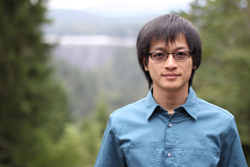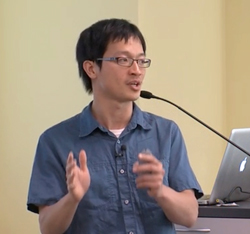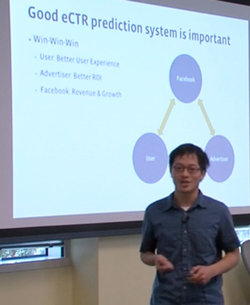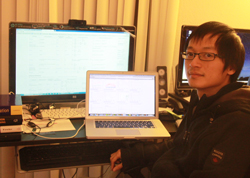Junfeng Pan
We are excited to feature Junfeng Pan, currently a research scientist at Facebook in Menlo Park, California. After completing extensive coursework for his Masters and Ph.D. in computer science in China, Pan moved to the United States to work for Google, and now Facebook, in the ever-expanding world of data mining and machine learning. A dedicated Sigma Xi member, Pan's current work in artificial intelligence constantly requires interdisciplinary science knowledge and teamwork. He is an outstanding example of the fresh face of Sigma Xi's future and we are proud to feature him here in our Meet Your Fellow Companions Series.
Tell us about your educational background including your doctoral research, if applicable.
I received my BS degree with honors in Computer Science from Sun Yat-sen University in Guangzhou, China, in 2003, and my Ph.D. degree in Computer Science from the Hong Kong University of Science and Technology (HKUST) in 2008. Currently, I am a Research Scientist at Facebook in Menlo Park, California. I lead online learning at Facebook for ads ranking. Prior to joining Facebook, I was a Research Engineer from 2008–2010 at Google in Mountain View, California. I was a visiting researcher at Massachusetts Institute of Technology (MIT) in 2007. My main research interests are machine learning and data mining, and their applications in query understanding, ads optimization and mobile computing.
honors in Computer Science from Sun Yat-sen University in Guangzhou, China, in 2003, and my Ph.D. degree in Computer Science from the Hong Kong University of Science and Technology (HKUST) in 2008. Currently, I am a Research Scientist at Facebook in Menlo Park, California. I lead online learning at Facebook for ads ranking. Prior to joining Facebook, I was a Research Engineer from 2008–2010 at Google in Mountain View, California. I was a visiting researcher at Massachusetts Institute of Technology (MIT) in 2007. My main research interests are machine learning and data mining, and their applications in query understanding, ads optimization and mobile computing.
I have had more than twenty papers published in top tier conferences and journals in my field, specifically the Institute of Electrical and Electronics Engineers (IEEE), Association for Computing Machinery (ACM) and the American Association for Artificial Intelligence (AAAI) societies. My papers are broadly cited in academia and industry as well as in textbooks such as "Search User Interface" (Marti Hearst, 2009). I have served in many senior leadership roles for academic conferences and journals in my field and actively review grant proposals. In addition, I am proud to be a senior member of IEEE.
In 2005, I was awarded the Creativity Award, Precision Award and Performance Award at the Association of Computing Machinery (ACM) Knowledge Discovery and Data Mining (KDD) Cup (one of the highest honors in the field of predictive modeling and data mining). My work was reported in the ACM KDD Exploration Newsletter. In 2009, my work on semi-supervised learning user understanding was described at an invited talk for the International Joint Conference on Artificial Intelligence (IJCAI). In 2010, I won Google's most prestigious Executive and Management Group (EMG) Award for my contribution in ads quality and user query understanding. In 2012, my co-authored work on learning based mobile behavior understanding was described in Science Daily.
Do you have a particular teacher or professor who inspired your love of science? Why?
 I have been focusing on artificial intelligence, machine learning and behavior understanding for 10 years. My Ph.D. advisor, Dr. Qiang Yang (IEEE Fellow, ACM Distinguished Scientist, AAAS Fellow and IAPR Fellow), first led me into the field toward the end of my undergraduate studies in February 2003. At that time, I was working on my final project with Dr. Kaile Su and deciding on a career. Dr. Su introduced me to Dr. Yang, who gave me my first problem on the topic of Customer Relationship Management – "how to predict whether a customer would buy a certain product given their demographic profiles and partial buying history." I ended up building an Artificial Neural Network (ANN) model and received great results with Dr. Yang's mentorship.
I have been focusing on artificial intelligence, machine learning and behavior understanding for 10 years. My Ph.D. advisor, Dr. Qiang Yang (IEEE Fellow, ACM Distinguished Scientist, AAAS Fellow and IAPR Fellow), first led me into the field toward the end of my undergraduate studies in February 2003. At that time, I was working on my final project with Dr. Kaile Su and deciding on a career. Dr. Su introduced me to Dr. Yang, who gave me my first problem on the topic of Customer Relationship Management – "how to predict whether a customer would buy a certain product given their demographic profiles and partial buying history." I ended up building an Artificial Neural Network (ANN) model and received great results with Dr. Yang's mentorship.
ANN is a very simple mimicry of the human brain, which simulates how nerve cells build up the connections, reactions and form a network. My work on this project was published in IEEE Intelligent Systems. This early success inspired me to enter into the fields of data mining, machine learning and artificial intelligence and I have been driven by the beauty of mathematics and the theory of science for ten years since then.
What is the focus of your current research?
Currently, my main focus is on maximizing the user and advertiser experience by finding the best matches of ads and users from user responses. It is a complex smart learning model and system that can learn on large scales and in nearly real time. It simulates the human learning process at a certain level. For example, when we learn to play a song on the piano, there is an easy and a hard part. When we make a mistake, we focus on the challenging part and practice to improve. Our learning system is similar to this learning process as it moves through the stages of prediction, actual user feedback, recognition of the error, then improvement of the prediction in real time. The difference is that, our model and system work at scale. It is a distributed system spread out over a huge set of machines in multiple global regions. It learns and predicts in the magnitude of billions or trillions on a daily basis.
maximizing the user and advertiser experience by finding the best matches of ads and users from user responses. It is a complex smart learning model and system that can learn on large scales and in nearly real time. It simulates the human learning process at a certain level. For example, when we learn to play a song on the piano, there is an easy and a hard part. When we make a mistake, we focus on the challenging part and practice to improve. Our learning system is similar to this learning process as it moves through the stages of prediction, actual user feedback, recognition of the error, then improvement of the prediction in real time. The difference is that, our model and system work at scale. It is a distributed system spread out over a huge set of machines in multiple global regions. It learns and predicts in the magnitude of billions or trillions on a daily basis.
Tell us about something we might see in our daily lives that directly correlates to your work.
This is the most straightforward question I can answer. If you are a Facebook user, you see my work. Facebook has over 1 billion monthly active users, forming the largest scale social network on the planet.
Give us an example of how multi-disciplinary research directly contributed to your work.
This is the most exciting part of my work, as it crosses at least three domains. First, I work on real-time learning and prediction models and systems, which are based on a solid foundation of mathematics, probability and artificial intelligence, all of which aim to simulate human learning. Secondarily, we research user behavior in our social network while preserving privacy. Finally, we work to understand advertiser behavior. Advertisers provide bids for their ads in a variety of formats. We work to optimize multiple objectives that are most suited to auction mechanics. Auction Theory is widely studied in the field of economics.
my work, as it crosses at least three domains. First, I work on real-time learning and prediction models and systems, which are based on a solid foundation of mathematics, probability and artificial intelligence, all of which aim to simulate human learning. Secondarily, we research user behavior in our social network while preserving privacy. Finally, we work to understand advertiser behavior. Advertisers provide bids for their ads in a variety of formats. We work to optimize multiple objectives that are most suited to auction mechanics. Auction Theory is widely studied in the field of economics.
What are your thoughts on the future of STEM education?
Interest is one important key. Science, technology, engineering and mathematics are highly correlated fields. Many students may become frustrated at the complexity of an equation at the beginning. However, it is up to us to better communicate to students that an interesting problem and the search for its answer, can be both inspirational and rewarding. Once they find the beauty in STEM, it will drive students forward.
Describe the patent/publishing experience—were there any bumps along the way for you?
I have published more than twenty papers in my field. These papers mainly focus on innovative learning models and systems for user behavior understanding. For example, how to understand a user query in a search engine, to then find the best matched information and also how to understand user intent in a mobile environment with a variety of sensors. The most challenging part for me is narrowing down the topic to a concrete problem, making good assumptions and doing the required experiments. In many cases, you suddenly come up with a good idea and you do a survey. However, you may find that a paper with a similar idea has already been published or the idea does not work, even after you have spent a great deal of time on the experiments. Once we complete the research, the paper writing and publishing process has been, in my experience, quite smooth.
What has the honor of induction into Sigma Xi meant to you?
It was a great honor for me to be accepted as a member. It meant that my work was not only recognized by those in my own field, but also in a broader research Society. My acceptance continues to stimulate me to move forward in my research.
Has Sigma Xi helped further your career? If so, how? If you haven’t started your career yet, how do you believe Sigma Xi will serve you in the future?
Sigma Xi has helped me broaden my vision in multi-disciplinary research. It inspires me to think out of the box when I meet challenging problems.
What books are you currently reading for pleasure?
I have not read any books recently. I read articles and news on the Internet. The material I enjoy most includes the topics of entertainment, economy and science.
When you're not working on your research, what do you do in your free time?
I am into hiking. We are fortunate to have good weather here in the San Francisco Bay area with access to a lot of hiking trails.
What’s your favorite movie?
I have several favorite movies. "The Shawshank Redemption" is my favorite. "Source Code" and "Inception" are also at the top of my list.
What is your favorite motto?
"Many of life's failures are people who did not realize how close they were to success when they gave up." —Thomas Edison
What advice would you give a young researcher just starting out in your field?
Find an interesting problem that inspires you, it will push you forward.
Sigma Xi just celebrated its 125th year. What advances do you see in your field of research over the next 125 years?
Honestly, I feel better talking about the next decade. In the fields of machine learning and data mining, one direction is big data. As the information thrives, there will be more and more available data in various volume and formats. How to extract and represent the knowledge in a super large scale and fast changing environment is an ongoing challenge in my field of research.